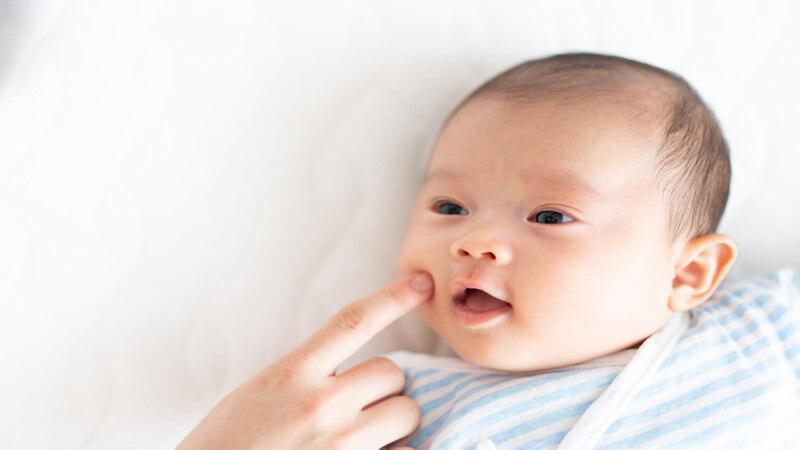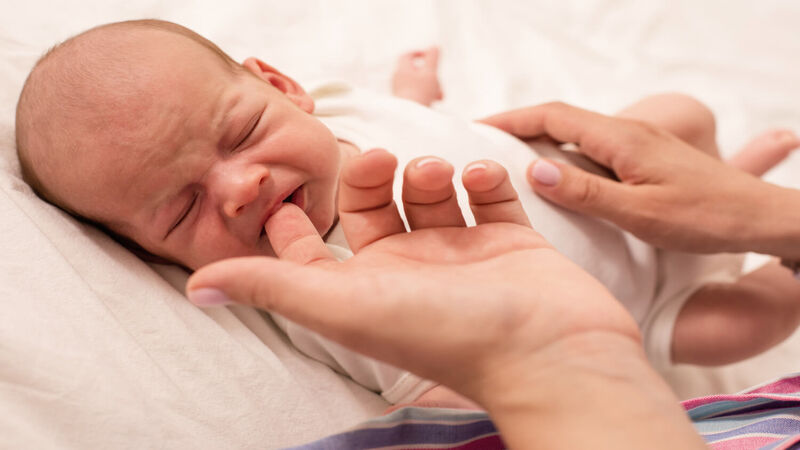
Babies are born with several reflexes, or involuntary reactions, each of which plays a crucial role in their survival, growth, and development (1). These reflexes typically fade as the infant matures. They are essential for babies because each reflex contributes to the development of specific skills. For instance, the rooting reflex helps establish the ability to suck breast milk and feed in later years. Similarly, the stepping reflex serves as a precursor to walking and other movements.
After birth, babies experience significant environmental changes, transitioning from a warm, protected, and dark womb to a world filled with light, noise, sounds, and smells. Everything they encounter is entirely new to them. Consequently, they must make many adjustments, supported by their primitive reflexes. In this article, we will explore the rooting reflex in babies and the natural process by which the body loses this reflex.
What is a Rooting Reflex in Babies?
The rooting reflex is one of the most essential reflexes in babies that helps them adjust to the world. It is essential because it is associated with their feeding. Rooting reflex means a reflexive action produced by a baby when you gently touch its cheek or corner of the mouth. In this reflex, a baby turns around and opens its mouth in the direction it felt the touch.
This reflex helps a newborn baby find the breast or the bottle to help with feeding. By about the third month, babies lose this reflex and naturally start looking for food.
When Does the Rooting Reflex in Babies Start?
Babies are born with a set of primitive reflexes that help them to go through and adjust to the new world. Most of these primitive reflexes develop in the womb. The rooting reflex is also among them, which naturally develops within 28-30 weeks after conception. (2a) This rooting reflex helps a baby to find its mother’s breast. The rooting reflex is followed by the sucking reflex, which is also a very essential part of their feeding, originally developed in the womb.
Therefore, in some cases, when babies are born premature (before 28 weeks), they may not have the rooting reflex. Also, in some cases, babies develop the sucking reflex but still do not have the rooting reflex.
[Read: Spoon-Feeding a Newborn]
How to Test For Rooting Reflex in Babies?

Testing the rooting reflex in your baby is quite easy. To test the rooting reflex in your baby, just gently stroke the cheek of your baby or touch the corner of their mouth with your fingers or nipple and look for the response. Your baby will immediately respond by making sucking movements, trying to look for milk.
How Long Does the Rooting Reflex Last?
These reflexes develop in the baby at different times, including the time before and after birth, and help them to find the breast for food. They develop at a certain time and disappear after a period naturally. The rooting reflex lasts in a baby for the first 4 months (2b). Sometimes, the rooting reflex can disappear before time and babies will be able to turn their heads and find the right position for sucking naturally. Also, they will not respond to every touch with searching for food when they grow hunger cues.
Also, in some cases, the rooting reflex can stay longer than the normal period, especially when the baby has developed the rooting reflex later than usual.
Does Rooting Reflex Mean Baby is Hungry?
The rooting reflex helps babies to find the source of food, but this does not always mean your baby is hungry. Naturally, the rooting reflex can be triggered through some simple steps, such as touch or a gentle touch on their cheek or the corners of the mouth. And so, the rooting reflex can be triggered easily but this does not always hint that they are hungry. It can be a mere reflex as they are still not adjusted to respond differently with every touch.
[Read : How to Know Your Baby is Hungry – Know the Signs]
When to Seek Help From Doctors?

Testing the primitive reflexes in babies is an important part of a newborn health and wellness checkup. Doctors always check these instincts when examining a baby.
Testing the rooting reflex is easy and you can easily keep track of their rooting reflex on your own. The rooting reflex develops in the baby before birth and stays for 3-4 months after birth. But if you face the below-mentioned issues below, you can check with the pediatrician.
- The rooting disappears before time and comes back after a time.
- The rooting lasts in the baby for more than 6 months.
The rooting reflex in babies is a natural reflex that appears at birth and disappears in due course. It is one of the many reflexes that babies have. There is not much that parents can do about this reflex except let things take their course.
FAQ’s
1. Is Rooting a Sleepy Cue?
The rooting reflex helps infants locate food sources, like breasts or bottles and is linked to hunger cues.
2. Is the Rooting Reflex and Sucking Reflex The Same?
The rooting reflex allows the baby to locate the breast or nipple, while the sucking reflex enables them to consume food. Although these two reflexes are closely related, they are distinct from one another.
3. Is Rooting a Hunger Cue?
Rooting is a primitive reflex related to feeding in babies, but it is not a hunger cue, as hunger cues develop soon after the rooting reflex disappears. Rooting can sometimes be influenced by hunger cues.
Read Also: Sucking Reflex in Babies—When Does it Develop?
Reference
- Alexa K. Modrell; Prasanna Tadi Affiliations, Creighton University, Asram Medical College, Eluru, India—https://www.ncbi.nlm.nih.gov/books/NBK554606/
- Hannah Yoo; Dana M. Mihaila. SUNY Upstate Medical University – https://www.ncbi.nlm.nih.gov/books/NBK557636/
